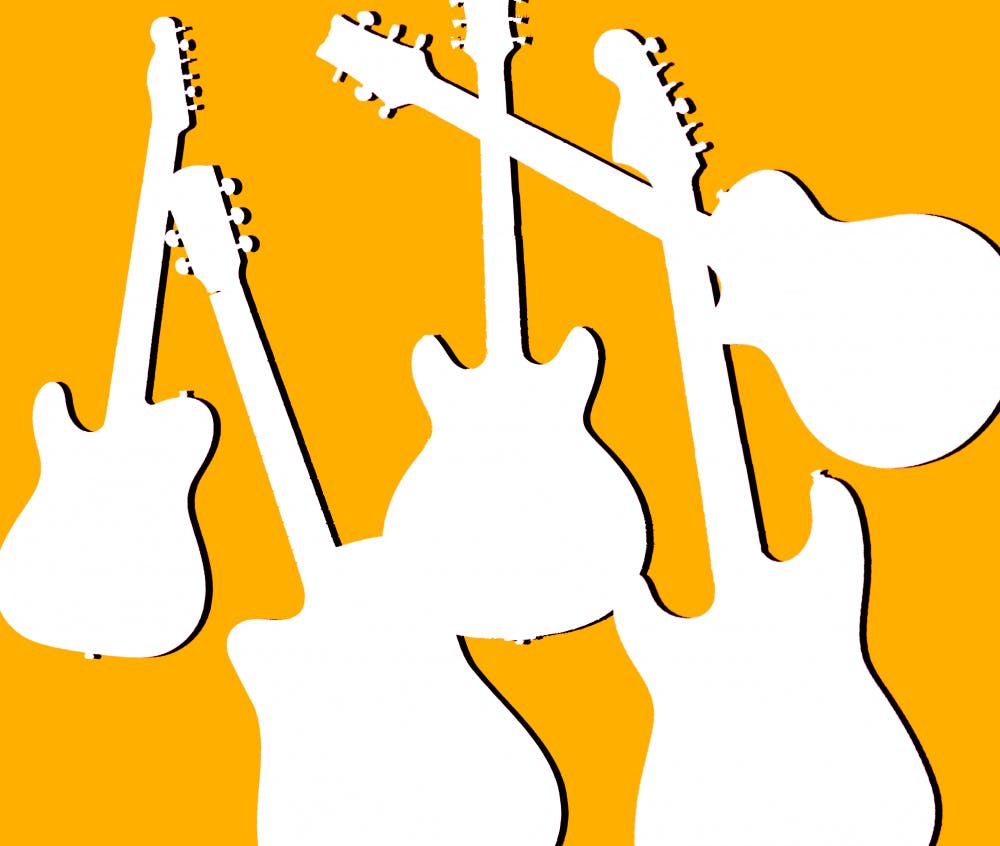College is supposed to be a time for trying new things and figuring out who you are, which for some of us serves as an invitation to finally buy that mahogany Gibson Les Paul you’ve been wanting to learn how to play ever since fourth grade. Then, you go to the Gibson website and see that the guitar of your dreams costs just shy of $3,000 and think maybe playing an instrument isn’t for you.
Fear not, young aspiring guitarist! Buying and learning a new instrument has never been easier, as long as you know where to look.
There’s no need to sacrifice quality for price. Budding guitarists often make one of two mistakes: either they buy the cheapest guitar in the store and become frustrated by the sound quality, or they buy the most expensive and wonder why they don’t immediately sound like Jimi Hendrix. While there isn’t always that much difference between a $300 and $3000 instrument in the hands of someone who knows what they’re doing, below a certain price your guitar just won’t sound right. Luckily, there are a bunch of great options for new guitars out there that won’t blow your budget.
My first guitar was a Rogue RD80 acoustic that I bought new for under $100, but after about three years of regular playing, I was looking for something for more advanced musicians, at which point I upgraded to an Ibanez V70ce. Yamaha offers several acoustic and acoustic–electric models under $500, and a few at or under $200, like the FG800.
As for those who prefer electric models, both Fender and Gibson offer cheaper lines of their signature models: the Fender Squier and Gibson Epiphone lines boast big names like Stratocaster, Telecaster, Les Paul, and Flying V in the $350–$500 price range. Other makers like Gretsch and Ibanez, rather than a separate line, simply have dressed–down models for those on a budget, like the G5425 Jet Club and the Gio Ibanez.
You can also always look for used options, but don’t rely on online images or review. Make sure to get your hands on a guitar before you commit to it. The most important thing to consider when buying a guitar is how it feels in your hands. As much as I love the sound and look of a Gibson ES-335, it feels awkward and clumsy whenever I try to play it, whereas any Gretsch from the G5425 to the Penguin feels natural, and playing comes easier. Never buy a guitar without holding and playing it a bit first, even if all you know is “Hot Cross Buns.”
Check out local used guitar shops if you want a budget friendly option and unique sound. The biggest decision that anyone has to make when buying a guitar is whether to purchase it online or in person, a decision compounded by differing price points and the difference between carrying an instrument home on SEPTA and hoping it doesn’t get damaged in the mail.
For in–person purchase options, Philly offers a variety of independent music stores with mostly used and sometimes eccentric offerings. DiPinto Guitars in Fishtown is one of the more popular options, boasting vintage instruments and accessories as well as its own line of electric guitars and basses. On and around South Street, you can find Bluebond Guitars, BridgeSet Sound, Vintage Instruments, and South Street Sounds. The Classical Guitar Store by Rittenhouse Square offers a wide range of nylon–string classical guitars for students and concert musicians alike. Because these are all small businesses that deal mostly in used instruments, big names may be more difficult to find, and once again the importance of playing before purchase comes to the forefront. Just because Led Zeppelin nearly always used Les Pauls doesn’t mean every garage rocker has an obligation to buy one. Queens of the Stone Age frontman Josh Homme makes a point to buy rare, unique, and yes, sometimes cheap guitars to create his desired musical sound.
Or, if you’re looking for a specific model, head to these online instrument retail staples. For those hard–bent on a particular model, online is the answer. Guitar Center and Sweetwater have massive collections of musical instruments at retail value, while Reverb is the eBay of musical instruments, allowing for the purchase of high–quality guitars at relatively low price points. eBay itself also allows for guitar sales, as do Craigslist and Facebook marketplaces like Free and For Sale, but those tend to be less reliable than Reverb.
Getting the guitar is just the beginning. Next, you need to think about accessorizing appropriately. As nice as it would be if the guitar came with everything we needed, a few more purchases are required to make the instrument complete. Picks come a dime a dozen or even less and are mostly interchangeable, while the choice of guitar strap is up to the player’s desired aesthetic. Capos are an invaluable and fairly cheap tool for adjusting key on the fly. Transporting the instrument necessitates a case, either a lightweight gig bag or a heavier, more protective case. Electric guitarists will end up spending a bit more on a high–quality cable and amp. While most of the expensive amps are too large and loud for a dorm room anyway, be sure to read the dials before buying: some cheap amplifiers don’t allow you to adjust for midrange tones, resulting in a lower sound quality.
Okay, you now have everything you need, but how do you even play this thing? When it comes to lessons, Penn students have a few options. Self–teaching is the cheapest, through Hal Leonard tab books and YouTube tutorials, but it is the most time–consuming and labor–intensive method. Most instrument stores in town will offer lessons and repairs as well, but luckily as a student at Penn you can take music lessons for credit (and for a fee) from instructors like jazz and rock guitarist Matt McCloskey.
Buying and learning how to play a new instrument is achievable, even on a college budget; all you need is a heavy dose of research and a chance to hold a few dozen guitars until the right one calls out at the right price.







